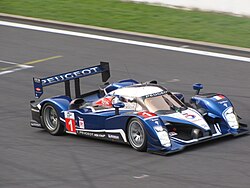
The Audi R8 is a Le Mans Prototype sports-prototype race car introduced in 2000 for sports car racing as a redevelopment of their Audi R8R and Audi R8C used in 1999. In its class, it is one of the most successful racing sports cars having won the 24 Hours of Le Mans race in 2000, 2001, 2002, 2004, and 2005, five of the six years it competed in total. Its streak of Le Mans victories between 2000 and 2005 was broken only in 2003 by the Bentley Speed 8, another race car fielded that year by Volkswagen Group.

The 24 Hours of Le Mans is an endurance-focused sports car race held annually near the town of Le Mans, France. It is widely considered to be one of the world's most prestigious races, and is one of the races—along with the Monaco Grand Prix and Indianapolis 500—that form the Triple Crown of Motorsport, and is also one of the races alongside the 24 Hours of Daytona and 12 Hours of Sebring that make up the informal Triple Crown of endurance racing. Run since 1923, it is the oldest active endurance racing event in the world.

ORECA is a French racing team and race car constructor, founded in 1973 and run by Hugues de Chaunac, former team manager of F1 team AGS. Oreca has had success in many areas of motorsport. Since the early 1990s the team has concentrated on running sports cars and GT cars.

The 75th 24 Hours of Le Mans was a 24-hour automobile endurance race for Le Mans Prototype and Grand Touring cars, which took place at the Circuit de la Sarthe, near Le Mans, France, from 16 to 17 June 2007. It was the 75th edition of the event, as organised by the automotive group, the Automobile Club de l'Ouest (ACO) since 1923. Unlike other events, it was not a part of any endurance motor racing championship. A test day was held two weeks prior to the race on 3 June. The event was attended by 250,952 spectators.
Joest Racing is a sports car racing team that was established in 1978 by former Porsche works racer Reinhold Joest. Their headquarters are in Wald-Michelbach, Germany.
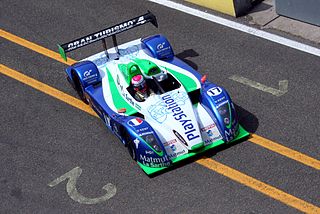
Pescarolo Sport was a motorsport team based in Le Mans, France, and founded in February 2000 by French racing driver Henri Pescarolo and his friend and partner, French publisher François Granet. They raced in the Le Mans Series and the 24 Hours of Le Mans. In October 2007, Henri Pescarolo purchased Jacques Nicolet's Saulnier Racing and created Pescarolo Automobiles, with the racing team becoming a division of the new company. The Pescarolo Automobiles went into receivership on 15 June 2010. Following a liquidation sale, the company was resold back to Henri Pescarolo and rebranded as Pescarolo Team for the 2011 season. However, the team's financial situation did not improve, and was wound up in January 2013.

The Lola B08/60 is a Le Mans Prototype built by Lola Cars International. It is the first closed-cockpit sports prototype built by Lola since the 1992 T92/10. It started competition in 2008, with Aston Martin being among the first customers for their entry into the LMP1 category in Le Mans Series, albeit entering under Charouz Racing System banner.

The 2008 24 Hours of Le Mans was the 76th Grand Prix of Endurance, taking place on 14–15 June 2008 at the Circuit de la Sarthe, Le Mans, France, organised by the Automobile Club de l'Ouest (ACO). The test day was on June 1. The race was attended by 258,000 spectators. The Audi team's progress and victory was documented in the 2008 film Truth in 24.

The 2009 24 Hours of Le Mans was the 77th Grand Prix of Endurance, an endurance auto race run over 24 hours. It took place at the Circuit de la Sarthe, Le Mans, France, and was organised by the Automobile Club de l'Ouest (ACO) over 13–14 June 2009 and was started by Fiat and Ferrari chairman Luca Cordero di Montezemolo at 15:00 local time. A test day was initially scheduled for 31 May that year, but was canceled by the ACO due to economic concerns. The race was attended by 234,800 spectators.
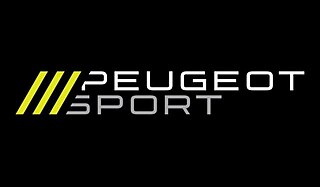
Peugeot Sport is the department of French carmaker Peugeot responsible for motorsport activities.
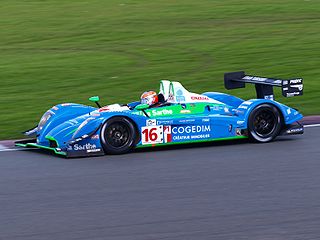
The Pescarolo 01 was the first sports prototype racing car built entirely by French team Pescarolo Sport. It had been designed to meet the LMP1 and LMP2 regulations for Le Mans Prototypes in the Le Mans Series as well as at the 24 Hours of Le Mans, and replace Pescarolo's previous C60 chassis which had been heavily modified from cars purchased through Courage Compétition. The 01s debut was at the 2007 1000 km of Monza.

The Audi R15 TDI, commonly abbreviated to the R15, is a Le Mans Prototype (LMP) racing car constructed by the German car manufacturer Audi AG. It is the successor to the Audi R10 TDI.

The Peugeot 908 is an auto racing car developed by Peugeot Sport in 2011 for the Le Mans Prototype category of racing. Powered by a diesel engine, it is the successor to the Peugeot 908 HDi FAP which competed since 2007. The newer 908 features a smaller diesel than its predecessor, utilizing a 3,700 cc (230 cu in) HDi V8 engine with Honeywell Turbo Technologies turbocharger in order to meet new regulations for 2011. The 908 has competed in all rounds of the 2011 Intercontinental Le Mans Cup including the 2011 24 Hours of Le Mans. The new 908 lost about 150 bhp compared to 2010 but improvements in the chassis and handling made the car much more agile. Unlike its predecessor the front tyres are the same width as the rear. The only part that has been reused from its predecessor was the windscreen wiper.
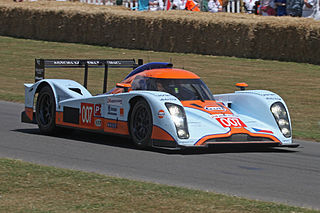
The Lola-Aston Martin B09/60, also known as the Aston Martin DBR1-2, is a Le Mans Prototype sports car built by Lola Cars International and co-developed with Prodrive for use by Aston Martin Racing. It is the first prototype to bear the Aston Martin name since the AMR1 in 1989. Aston Martin's internal name for the car, DBR1-2, refers to the specific DBR1 chassis which won six races in 1959 en route to clinching the World Sportscar Championship as well as that year's 24 Hours of Le Mans.

The 2009 Mobil 1 12 Hours of Sebring was the 57th running of the 12 Hours of Sebring and the opening round of the 2009 American Le Mans Series season. It took place at the Sebring International Raceway, Florida on March 21, 2009. Three new cars made their debut at Sebring: Audi's diesel R15 TDI, Acura's first LMP1 entry the ARX-02a, and the return of the BMW M3 to the GT2 category. It was also the last time GT1 category raced at the event.

The Oreca 01 is a Le Mans Prototype built by Oreca Racing in 2009. It replaced the Courage-Oreca LC70 raced previously by Oreca. It is powered by an engine from Japanese engine company AIM Power. It is a tuned Judd engine that develops 650 bhp/485 kW at 8000 rpm.
Diesel automobile racing can refer to any use of diesel as a fuel for racing cars. The diesel-fueled vehicle may be used in direct competition with other vehicles, in a separate Diesel class in the same racing event, or in a diesel-only event.

The 2010 8 Hours of Le Castellet was the inaugural round of the 2010 Le Mans Series season. It took place at the Circuit Paul Ricard, Le Castellet, France on 11 April 2010. It was the first Le Mans Series race that is longer than the standard 1,000-km distance the LMS use since the 2007 Mil Milhas Brasil. Audi Sport Team Joest won the race overall in their first use of the Audi R15 TDI in the Le Mans Series, with drivers Allan McNish and Rinaldo Capello. Aston Martin Racing and Rebellion Racing completed the overall podium five laps behind the winning Audi. Strakka Racing also brought Honda Performance Development a win on their debut in the LMP2 category, leading the OAK Racing Pescarolo by 33 seconds. Applewood Seven won the Formula Le Mans category, the first event in which this class participated in the Le Mans Series. Team Felbermayr-Proton dominated the GT2 category by finishing in the top two positions, ahead of the first of the AF Corse Ferraris.

TDI is Volkswagen Group's term for its current common rail direct injection turbodiesel engine range that have an intercooler in addition to the turbo compressor.

The Audi R10 TDI is a sports prototype designed and built by Audi in partnership with Dallara. Built to the Le Mans Prototype 1 (LMP1) regulations, the R10 was highly successful throughout its career; the R10 became the first diesel-powered car to win the 24 Hours of Le Mans in 2006, in what would be the first of three 24 Hours of Le Mans wins. Unveiled to the public on 13 December 2005 in Paris, the R10 would go on to win the 2006 24 Hours of Le Mans just 200 days later.
